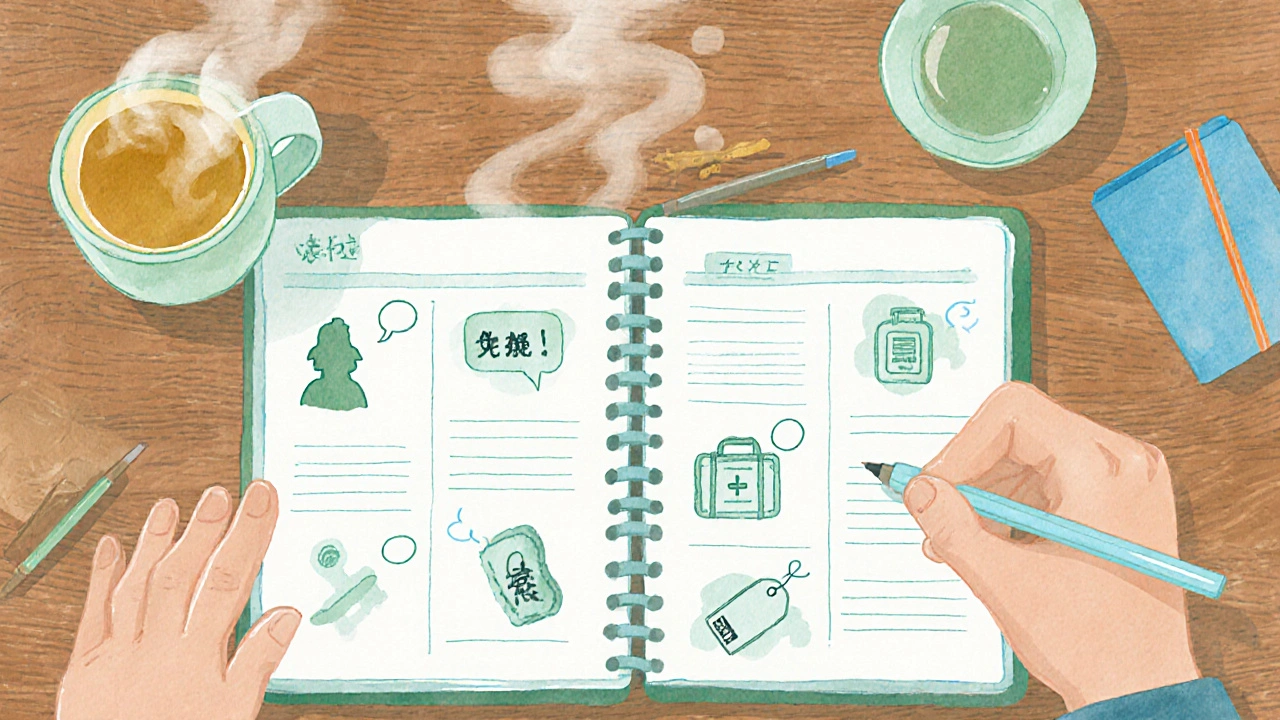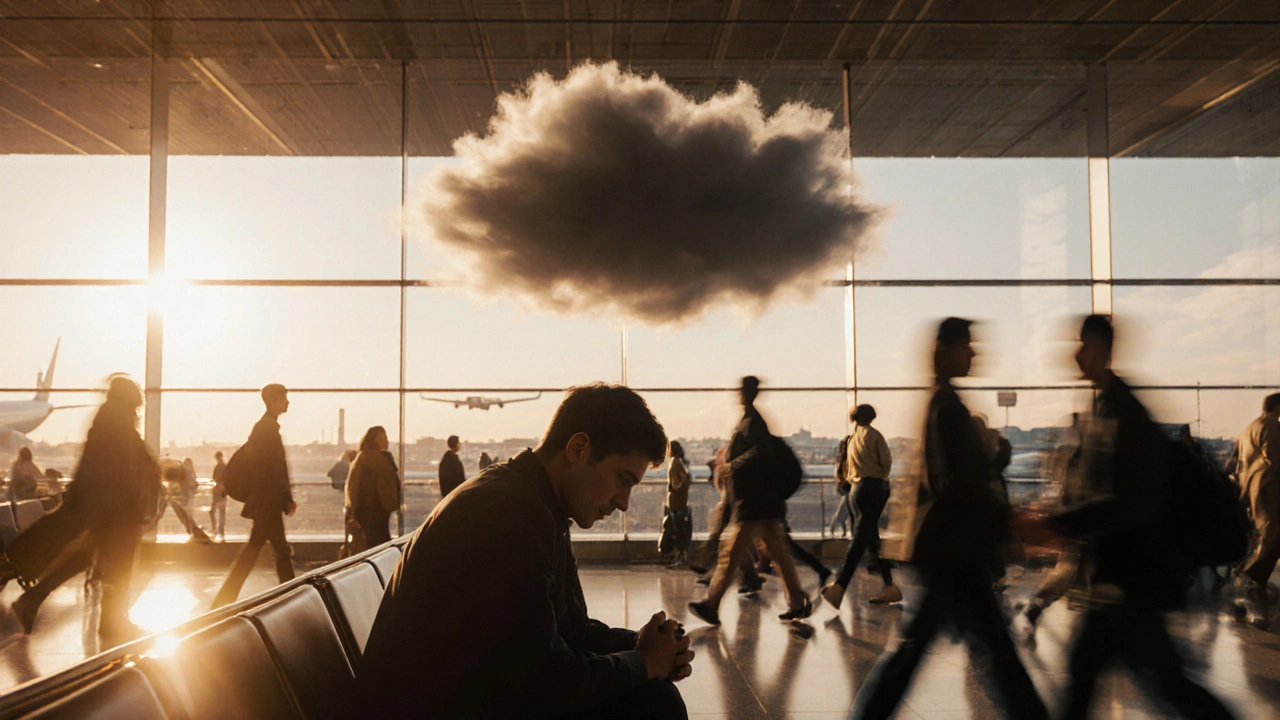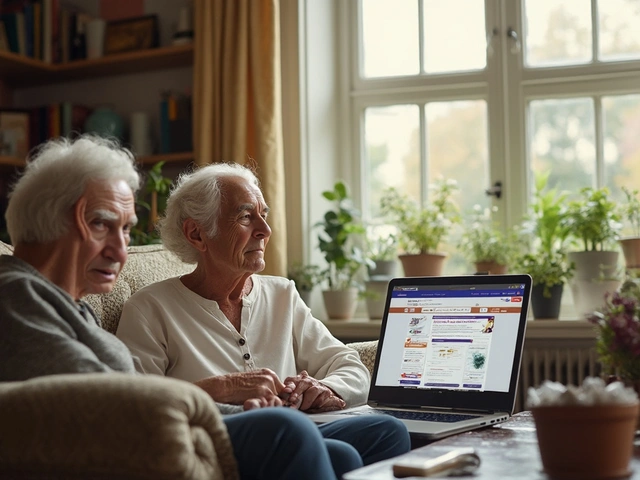Travel Anxiety Trigger Identifier
Select the triggers that resonate with you to discover personalized coping strategies.
Fear of Crowds
Worry about being overwhelmed in busy airports or popular tourist spots.
Language Barriers
Concern about miscommunication or misunderstanding cultural norms.
Health Worries
Anxiety about getting sick or accessing healthcare abroad.
Logistical Fears
Worry about missed connections, lost luggage, or timing issues.
Your Personalized Coping Plan
Quick Takeaways
- Identify anxiety triggers before you book.
- Use simple breathing or mindfulness tricks during the trip.
- Plan realistic schedules and build in buffer time.
- Bring comfort items and a packed checklist.
- If anxiety spikes, try grounding techniques or a short CBT exercise.
Ever feel a knot in your stomach as the departure day draws near? That uneasy feeling is often travel anxiety, a specific type of worry that pops up when you think about leaving home, navigating airports, or staying in an unfamiliar place. It’s not just a fleeting nervousness; for many, it can ruin the whole vacation experience.
Travel Anxiety is a condition marked by excessive worry, physical tension, and avoidance related to travel planning or execution. While everyone gets a bit jittery before a big trip, chronic travel anxiety may lead to missed flights, sleepless nights, or even canceling trips altogether.
Below you’ll find a step‑by‑step guide that tackles the problem from three angles: preparation, in‑trip coping, and post‑trip recovery. Follow each job‑to‑be‑done and you’ll turn a stressful getaway into a smoother, more enjoyable adventure.
1. Spot Your Triggers Before You Book
Understanding what fuels your anxiety is half the battle. Common triggers include:
- Fear of crowds at airports or tourist spots.
- Uncertainty about language or cultural norms.
- Health worries-like getting sick abroad.
- Logistical nightmares: missed connections, lost luggage.
Write them down in a Travel Planner a digital or paper notebook where you record itinerary details, contacts, and contingency plans. Seeing the worries on paper helps you address each one directly.
2. Build a Stress‑Reduced Itinerary
Overpacking your schedule is a surefire way to amplify Stress the body’s response to perceived threats, releasing cortisol and adrenaline. Instead, adopt these rules:
- Reserve at least half of each day for “free time.”
- Plan travel between attractions during off‑peak hours.
- Schedule a short rest break after any long transit.
Include a simple Packing Checklist a list of essential items-passport, meds, comfort item, charger-checked off before leaving home. Knowing you have everything reduces last‑minute panic.
3. Tackle Jet Lag and Physical Discomfort
Jet lag, a mismatch between your internal clock and the destination’s time zone, can masquerade as anxiety. Combat it by:
- Gradually shifting sleep times 2-3 days before departure.
- Staying hydrated-avoid alcohol and excess caffeine.
- Getting sunlight exposure during the day.
If you’re traveling eastward, consider a short course of melatonin (consult a doctor first). Managing jet lag reduces the physical strain that often triggers anxious thoughts.
4. Mindfulness and Breathing on the Move
Two portable techniques work wonders when a flight delay or crowded station spikes your nerves:
- Breathing Exercise a focused inhalation‑exhalation pattern that lowers heart rate in under a minute: inhale for 4 seconds, hold 4, exhale 6, repeat five times.
- Mindfulness a practice of staying present by observing thoughts without judgment: notice the texture of your seat, the sound of wheels, then let the worry pass.
Practice these on a quiet corner of the airport or even while waiting in line. The key is regularity-do them whenever you feel tension rising.

5. Cognitive Behavioral Tools for On‑The‑Spot Relief
When anxiety feels overwhelming, a quick CBT (Cognitive Behavioral Therapy) technique can rewire the reaction:
- Identify the automatic thought (e.g., “I’ll miss my connecting flight”).
- Challenge it with evidence (you’ve set a buffer, airline alerts are real).
- Replace it with a balanced statement (“I have a plan, and I can handle a delay”).
Even if you’re not seeing a therapist, these steps act like a mental first‑aid kit. Write them on a sticky note in your wallet for quick reference.
6. Safety Nets: Insurance and Support
Knowing you’re covered financially eases a big chunk of travel worry. Choose a policy that includes:
- Trip cancellation or interruption reimbursement.
- Medical evacuation and COVID‑related care.
Also, share your itinerary with a trusted friend or family member. A simple text check‑in each evening can provide reassurance and a backup contact if something goes off‑track.
7. Post‑Trip Reflection and Reset
After you return, take 10 minutes to journal about what triggered anxiety and what helped. Over time you’ll spot patterns-maybe airports are fine but unfamiliar hotels spark worries. Use those insights for your next trip’s planner.
Finally, reward yourself. Whether it’s a favorite meal or a quiet day at home, acknowledging that you faced your fear reinforces a positive feedback loop.
Quick Comparison of Relief Techniques
| Technique | Time to Benefit | Best For | Requires Preparation |
|---|---|---|---|
| Breathing Exercise | Under 1 minute | Immediate spikes (delays, crowds) | No |
| Mindfulness Mini‑Pause | 1-2 minutes | General nervousness | Minimal (just focus) |
| CBT Thought Reframe | 2-5 minutes | Persistent worry loops | Practice beforehand |
| Travel Planner + Checklist | Days before departure | Overall trip anxiety | Moderate (setup) |
| Professional CBT Sessions | Weeks to months | Severe or chronic anxiety | Significant (therapy schedule) |
Next Steps Checklist
- Write down your top three travel triggers.
- Create a simple Travel Planner with dates, contacts, and buffer times.
- Pack a comfort item (e.g., favorite pillowcase) and add it to your Packing Checklist.
- Practice the 4‑4‑6 breathing pattern each night for a week.
- Buy travel insurance that covers medical emergencies and cancellations.
- Schedule a brief check‑in call with a friend on day three of your trip.
Frequently Asked Questions
Can travel anxiety be a sign of a deeper mental health issue?
Sometimes, intense travel anxiety reflects underlying conditions such as generalized anxiety disorder or agoraphobia. If worries persist beyond trips and affect daily life, consider speaking with a mental‑health professional for a proper assessment.
Is it safe to use melatonin for jet‑lag relief?
Melatonin is generally safe for short‑term use in adults, but dosage matters (0.5‑3mg taken an hour before bedtime). Always check with a doctor, especially if you’re on other medications or have health conditions.
What if I lose my passport mid‑trip? Does that trigger more anxiety?
Losing a passport is stressful, but preparation eases the panic. Keep a digital copy in a secure cloud folder, note the nearest embassy, and have a backup ID (e.g., driver’s licence). Knowing the recovery steps reduces the fear of the unknown.
Do I need professional therapy for mild travel anxiety?
Mild cases often improve with self‑help tools-breathing, mindfulness, and solid planning. Professional CBT is recommended if anxiety interferes with travel plans regularly or escalates despite self‑care.
How can I keep my kids calm if they also feel travel anxiety?
Involve them in the planning, let them pack a small “comfort bag,” and use the same breathing exercises together. Explain the itinerary in simple terms and set realistic expectations for rest breaks.




Elle McNair
Travel anxiety is something I’ve felt many times, especially before long flights.
One thing that really helps me is writing down the exact things that make me nervous and then tackling them one by one.
I keep my packing list short and include a small comfort item like a familiar tea bag.
Doing a quick 4‑4‑6 breathing exercise at the airport calms my nerves enough to enjoy the journey.
Dennis Owiti
I totally get the jittery feeling before a trip – I’ve been there many times.
My go‑to is to set up a simple itinerary with buffer times so I don’t feel rushed.
Also I download a translation app and practice a few key phrases the night before.
When I start to panic I write “it’s okay, I’m prepared” on a sticky note.
It sounds silly but seeing that little reminder really grounds me.
Justin Durden
One practical step is to allocate half of each day as free time; this reduces the pressure of ticking off every sight.
When you schedule travel during off‑peak hours you’ll avoid crowded terminals and noisy buses.
Try a short mindfulness pause before boarding – just notice the hum of the engine and let thoughts pass.
Keep a small notebook handy to jot down any sudden worries and later you can review how many were unfounded.
These small habits build confidence over time.
Sally Murray
Travel anxiety, while common, can significantly impair the enjoyment and benefits derived from international experiences.
It is therefore prudent to adopt a systematic approach that addresses both the cognitive and physiological components of stress.
Initially, the identification of specific triggers through a structured self‑assessment instrument facilitates targeted interventions.
Subsequently, the development of an exhaustive itinerary, inclusive of contingency buffers, mitigates uncertainty regarding temporal logistics.
Furthermore, the incorporation of evidence‑based relaxation techniques, such as diaphragmatic breathing and progressive muscle relaxation, attenuates autonomic arousal during periods of heightened tension.
Research indicates that regular practice of these techniques yields measurable reductions in cortisol levels, thereby improving overall emotional resilience.
In parallel, the procurement of comprehensive travel insurance serves as a financial safeguard, reducing apprehension related to unforeseen medical or logistical disruptions.
It is advisable to maintain digital and physical copies of essential documents, including passports, visas, and emergency contacts, to alleviate concerns pertaining to loss or theft.
Engaging a trusted confidante for periodic check‑ins further augments perceived social support, a factor known to buffer stress responses.
Post‑trip reflective journaling enables the consolidation of experiential learning, allowing the traveler to discern patterns of anxiety and effective coping mechanisms.
Such reflective practice should be structured, encompassing prompts regarding trigger identification, employed strategies, and outcome evaluation.
Over successive journeys, this iterative process fosters the development of a personalized anxiety mitigation repertoire.
Moreover, seeking professional consultation, particularly cognitive‑behavioral therapy, is recommended for individuals whose anxiety persists despite self‑guided efforts.
Clinicians can provide tailored cognitive restructuring techniques that directly challenge maladaptive thought patterns associated with travel.
By integrating these multifaceted strategies, the traveler can transform apprehension into purposeful preparation, thereby enhancing the qualitative experience of travel.
Bridgett Hart
The so‑called “proven tips” in this article are nothing more than regurgitated self‑help clichés lacking any substantive empirical backing.
Breathing exercises and mindfulness are presented as panaceas, yet the author neglects to address the systemic factors that provoke anxiety, such as corporate‑driven travel schedules and overcrowded airports.
Moreover, the checklist format trivializes a complex mental health condition, reducing it to a series of superficial tasks.
Any practitioner familiar with evidence‑based interventions would recognize the omission of exposure therapy and professional consultation as glaring oversights.
The recommendation to “buy travel insurance” is a shallow remedy that fails to confront the root psychological triggers.
One also notes the absence of cultural sensitivity, as the advice assumes a Western traveler paradigm.
In short, this piece reads like a marketing brochure rather than a rigorous guide for individuals grappling with genuine anxiety.
Readers would be better served by seeking peer‑reviewed literature or professional counseling rather than relying on this oversimplified handout.
Sean Lee
From a psycholinguistic perspective, the article appropriately leverages cognitive load theory by segmenting information into discrete modules such as trigger identification and contingency planning.
Utilizing a hierarchical schema-pre‑travel, in‑trip, post‑trip-optimizes working memory allocation, thereby facilitating procedural automation of anxiety mitigation protocols.
Furthermore, the inclusion of physiological self‑regulation techniques aligns with the somatic marker hypothesis, reinforcing affective forecasting accuracy.
Integrating digital assets like translation apps constitutes a form of techno‑cognitive scaffolding, augmenting linguistic competence in situ.
Overall, the multi‑modal strategy embodies an interdisciplinary approach, synthesizing behavioral activation, exposure desensitization, and risk management frameworks.
Cameron White
Looks like they’re selling a cookie‑cutter solution while big airlines keep us stuck in endless security lines.
Maybe the real anxiety comes from not knowing who’s watching our moves.
Anyway, having a backup plan is smart, just don’t trust the whole system blindly.
Keep a hidden cash stash and a fake ID just in case.
Amélie Robillard
Sure, breathing works… 🙄
Ashika Amirta varsha Balasubramanian
Start by mapping your top three triggers on a simple table, then assign a concrete counter‑measure to each-like a language app for language barriers or a pre‑packed first‑aid kit for health worries.
Next, share this plan with a trusted friend who can act as an accountability partner during the trip.
This dual approach not only externalizes your concerns but also creates a safety net that can be activated at any moment.
Remember, the goal is to transform anxiety from a paralyzing force into a signal that prompts proactive preparation.
Lorena Garcia
Honestly, I’ve found that packing a tiny plushie or a favorite snack can be a game‑changer when you’re stuck in a long layover.
Those little comforts remind your brain that you’re still in control, even if the airport feels like a maze.
Also, try the 4‑4‑6 breathing trick while you’re waiting for the gate-just count in your head, it’s super easy.
Give it a shot next time, you’ll thank yourself later.
Dietra Jones
i always keep a backup photo of my passport on my phone just in case i lose the real one.
also, a quick meditation on the plane helps lol.
don’t forget to set your phone on airplane mode else u get notif on wif.
Victoria Guldenstern
Oh great another “quick guide” that pretends a 5‑minute breathing exercise can magically erase years of ingrained anxiety – because obviously our mental health is that simple.
Sure, jot down a list, pack a pillowcase, and smile while the jet stream throws you into a cortisol‑inducing vortex.
Who knew that the secret to serene travel was simply not thinking about the fact that you’re paying exorbitant fees for a seat that barely reclines?
But hey, at least you’ll have a perfectly organized spreadsheet of your fears to show off at the next family dinner.
Bill Bolmeier
Bridgett you’re right that anxiety isn’t a one‑size‑fits‑all, but dismissing practical tools as “cliché” overlooks how many travelers actually find relief in those very techniques.
I’ve seen friends calm down with the 4‑4‑6 breath during a delayed flight, and it’s not just marketing fluff.
While systemic issues exist, offering tangible coping steps empowers people to take immediate action rather than feeling helpless.
So let’s give credit where it’s due and recognize that a blend of self‑help and professional help can coexist.